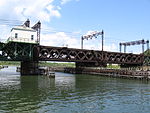Yankee Doodle Bridge
All pages needing cleanupBridges on the Interstate Highway SystemConnecticut building and structure stubsConnecticut transportation stubsFormer toll bridges in Connecticut ... and 4 more
Interstate 95Northeastern United States bridge (structure) stubsRoad bridges in ConnecticutUse mdy dates from October 2017
The Yankee Doodle Bridge carries Interstate 95 (Connecticut Turnpike) over the Norwalk River in Norwalk in the U.S. state of Connecticut.
Excerpt from the Wikipedia article Yankee Doodle Bridge (License: CC BY-SA 3.0, Authors).Yankee Doodle Bridge
Governor John Davis Lodge Turnpike, Norwalk
Geographical coordinates (GPS) Address External links Nearby Places Show on map
Geographical coordinates (GPS)
| Latitude | Longitude |
|---|---|
| N 41.1075 ° | E -73.4104 ° |
Address
Yankee Doodle Bridge
Governor John Davis Lodge Turnpike
06856 Norwalk
Connecticut, United States
Open on Google Maps








